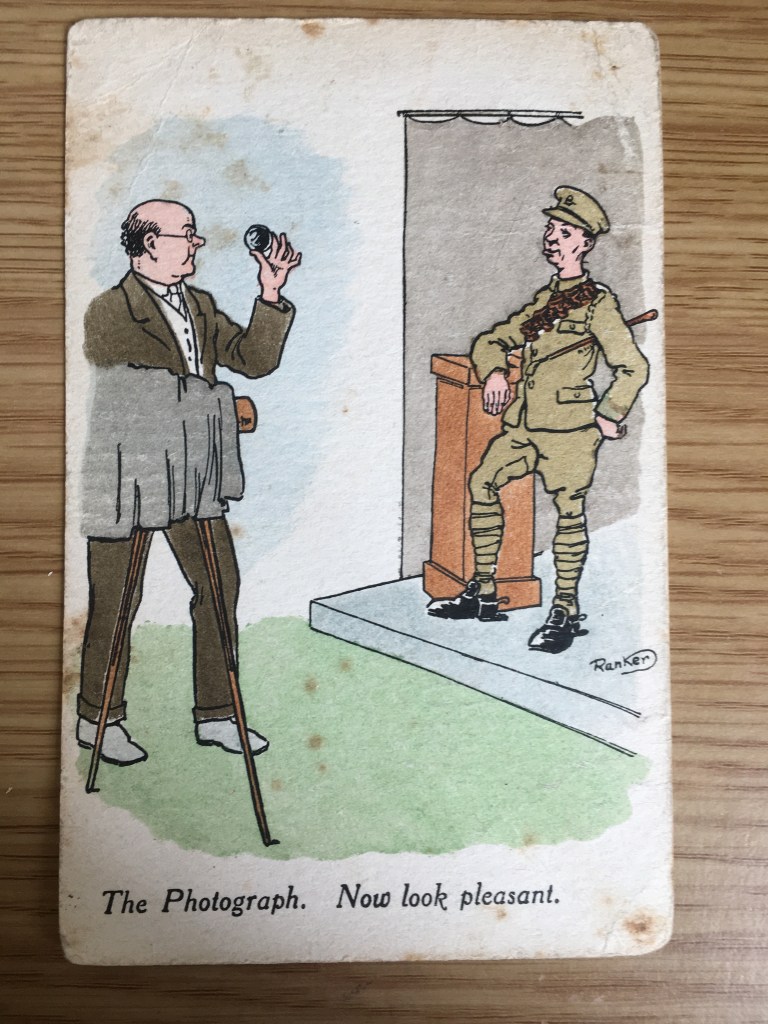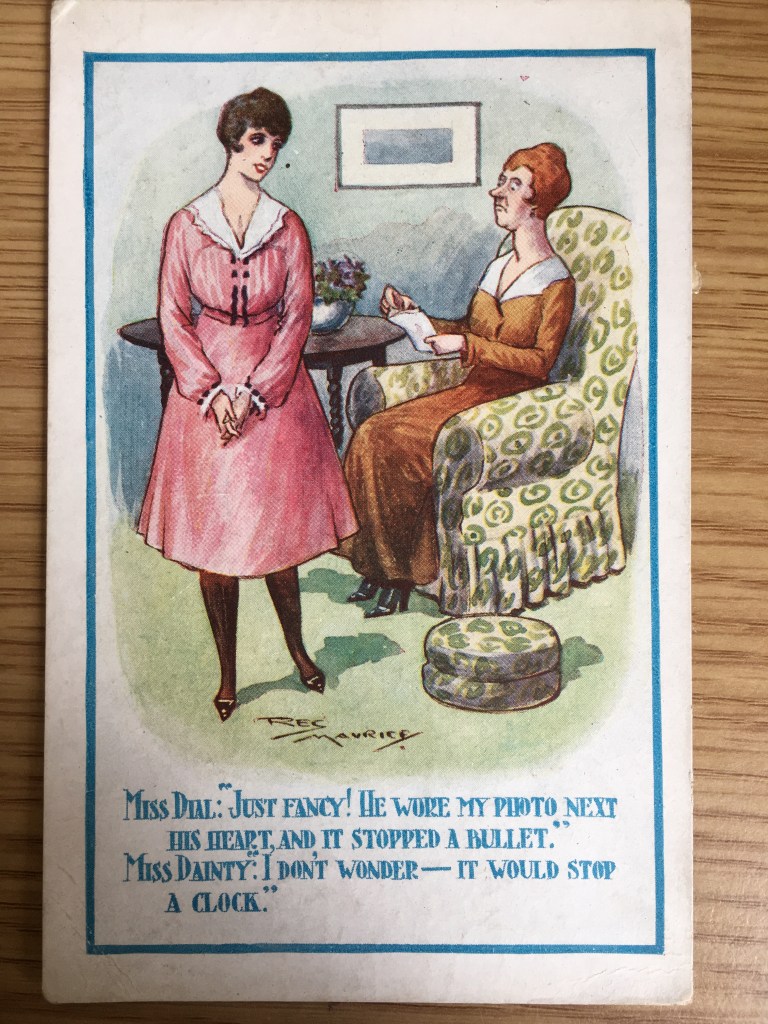
The chapter titled ‘Wounds’ begins with the words ‘[I]t is seldom that we have a serious accident’.[1] Written by the upper-middle class supervisor Monica Cosens, her memoire recalls her time at the Woolwich Arsenal. The hyperbolic language of this book jars with the picture of two wounded Munitionettes where this blog begins.
I first saw this image in the 1918 book by Mabel Daggert on a library shelf at the Imperial War Museum but have since purchased a page taken from the Manchester Guardian because at its centre was this picture.[2] Research for this Blog resulted in the discovery of an article featuring the same photograph in the Daily Record, 1917 (Figure 1). The photograph in question, features two munition workers who had sustained injuries during shifts in a munition factory. Many women lost their lives in explosions but, there were innumerable incidents of the loss of limbs, fingers, blindness or the removal of metal filings from flesh wounds or even eyeballs. The two women pictured were part of the ‘army of women’, as Mrs Alec-Tweddie called women war workers, and as such were not unusual.[3] However, what is unusual is the fact that their injuries sustained through war work had been documented and publicised. Stories were framed in terms of plucky heroism and the two women pictured, had been honoured with an O.B.E. for dedication to their war work. The caption to the photograph of Annie and Lily reads: ‘Two munition workers who were awarded the Medal of the Order of the British Empire for “bravery and devotion to duty,” in the course of which one had her left hand blown off, and the other lost two fingers.’[4]
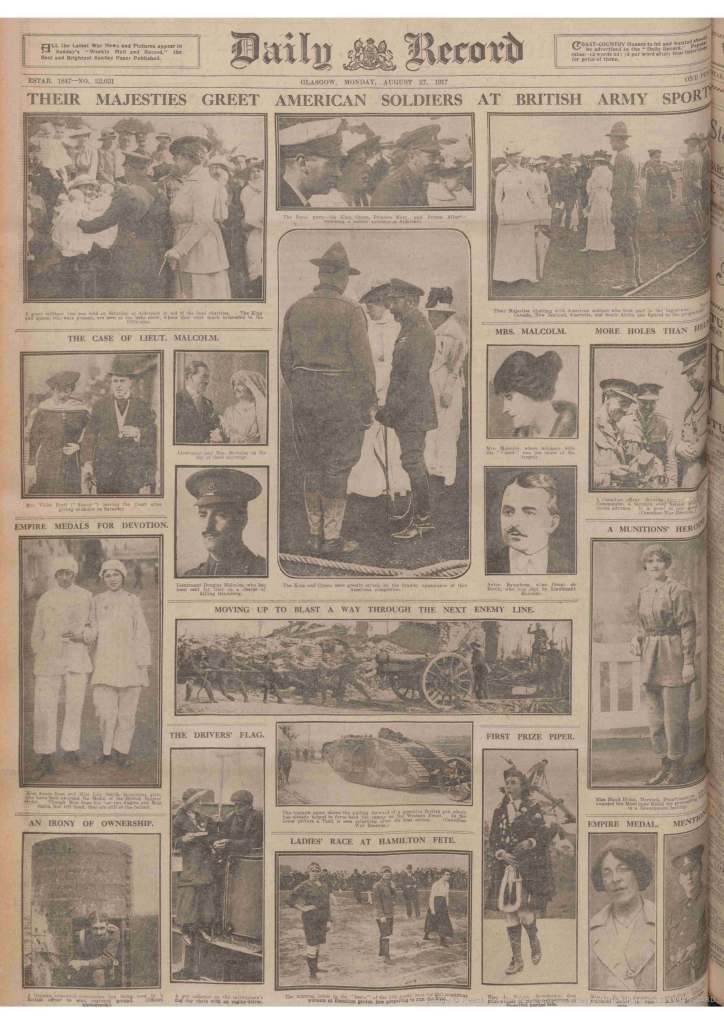
http://www.britishnewspaperarchive.co.uk
This led me to spend time searching through the British Newspaper Archive looking for reports on accidents at munition factories hoping to find names of women who had lost their lives or been injured. The frequency of incidents one suspects was extremely high, one reason being because, as we can see from the pamphlet Notes on the Employment of Women on Munitions of War, they carried out this dangerous work with very little protective clothing.[5] Figure 2 is a photograph from this pamphlet published, by the Ministry of Munitions, showing a Munitionette operating a lathe. She bends extremely close to the machine wearing no protective eyewear despite the swarf (metal fillings), which demonstrate how easily accidents could happen. The secrecy surrounding the locations and work of munition factories was certainly a factor in the lack of coverage and when explosions, accidents causing disfiguration, or deaths were acknowledged the details were superficial or the seriousness of life changing injuries were downplayed.
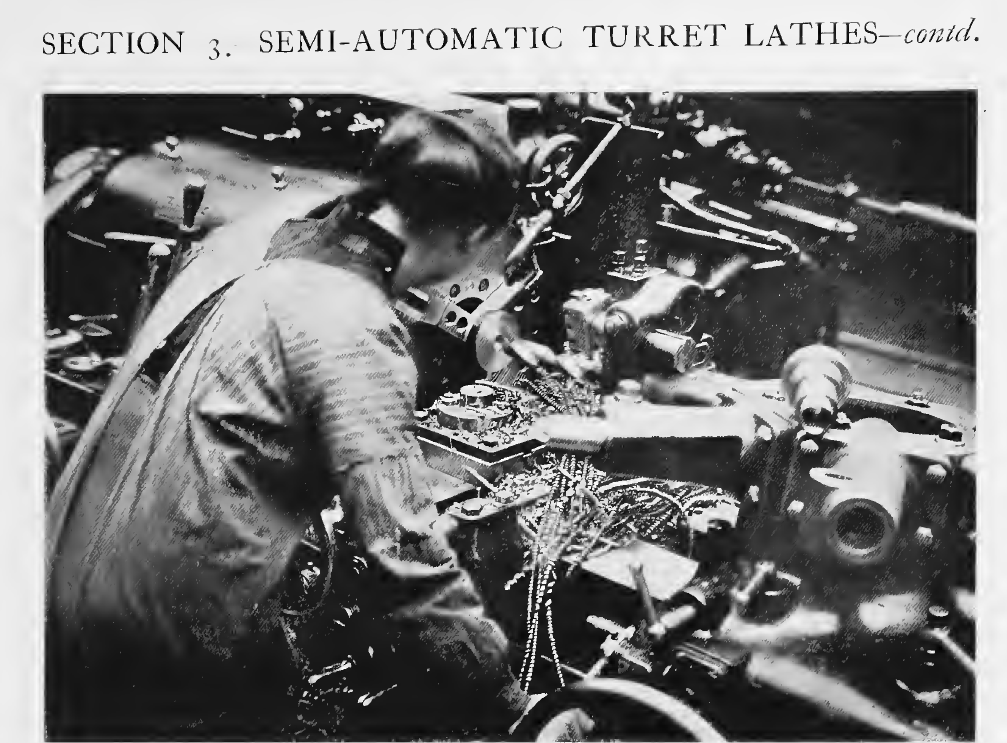
There were minor accidents and disfiguring illnesses caused by the highly volatile chemicals used, most notably T.N.T. Documents in the National archives which document female supervisors’ reports from 1919 make for grim reading. At the very beginning of the munition production drive when women began to be employed in this industry, welfare provisions were non-existent or at best extremely basic. There were many minor accidents and as the Mile End supervisor recalled in her Welfare Report of 1919:
“I was astonished to find that in those germ-laden surroundings the Doctor performed minor operations, such as cutting off fingers and toes.”
Mile End Supervisor’s Report, May 1919 Ministry of Munitions Archives, National Archives, London. Document Reference: MUN/5/92/346
Annie Slade, who worked at the National Filling Factory No.14 in Rotherwas Herefordshire, recalled women losing their fingers during night air raids as the lights suddenly went out but the machines continued.[6] The Workers’ Dreadnought featured a front-page article on the “Dangers of Munition Work” which described ‘the hideous dangers to which women and girl munition workers are subjected.’[7] The article exposes the exploitative working practices of the Vickers munition factory in Dartford using the experience of an ex-employee as their source. The woman told not only of the hard work but also the dangers:
Women and girls, some not more than 14 years of age, are carrying cleaning and painting cartridges weighing up to 20 lbs and lifting and arranging weighty boxes and trays of cartridges. They are performing operations which used to be thought heavy for strong men, and at one time they laboured from six a.m. to eight p.m. …… Explosions are of frequent occurrence. Young girls, ignorant of the enormous risks they are running, are employed on piece-work, incited by this method of payment they hurry with their work, though every hasty movement increases the risk.
“Dangers of Munition Workers” The Workers’ Dreadnought, 29th September 1917, Vol. IV. – No. 27 p.1
The article goes on to argue that safety was being sacrificed for “the defence of Vickers’ pocket” and that it was forbidden to mention accidents. The informant spoke of oiled rags being stuffed into the mouths of injured workers to stifle their cries.
Due to the secret nature of the work or the location of the factories many of the incidents of accidental injury were unreported with the exception of larger explosions. Several reported explosions included Silvertown, London, where 73 people were killed, and 300 people were injured on the 19th January 1917 at the Brunner, Mond & Co chemical factory.[8] At Chilwell, Nottingham, on 1st July 1918, 134 people were killed. A total of three separate explosions at the factory at Barnbow, Leeds firstly on the 5th December 1916 causing the death of 35 women, secondly the 21st March 1917 in which two women died and, finally, on the 31st March 1918 in which three men died.[9] There is no doubt from the reports that safety was ignored for the sake of expedited production. The Health of Munition Workers Committee was formed in 1915 by the Ministry of Munitions to investigate the effects of chemicals and working hours on the female workers. As a result of their findings the length of shifts were reduced as productivity was found to suffer when the workers became tired. Milk was distributed to those women working with T.N.T. as it was believed to counteract the side effects. There do seem to have been genuine efforts by the middle-class supervisors to take care of the health and well-being of the female munition workers.
As Angela Woollacott notes by 1916 a report published in the Lancet revealed the dangers of exposure to T.N.T as studied by Doctors Agnes Livingstone-Learmouth and Barbara Martin Cunningham who had spent five months studying munitions workers.[10] Certain measures were recommended including better ventilation in the factories, the frequent washing of uniforms and personal cleanliness. This developed into a regime of the women workers changing into gowns and washing (Figure 3) before eating and the distribution of milk or cocoa before a shift, believing that this would somehow neutralise the effects of the chemicals. Lilian Barker, The Lady Superintendent for the Woolwich Arsenal wrote in her Welfare Report: ‘the workers on powder were given milk or cocoa free of charge’ [11] but as Miss Parry noted in her report dated 15th July,1919, ‘it did not follow that because milk was provided it was necessarily drunk.’[12] The serious reactions to the chemicals that female munition workers were exposed to included: jaundice, nasal and throat problems, headaches, chest pains, abdominal pain, nausea, vomiting, constipation, diarrhoea, skin rashes, fainting, swollen hands and feet, drowsiness, depression, blurred vision, changes in menstruation, irritability and loss of appetite.[13]

https://www.iwm.org.uk/history/a-day-in-the-life-of-a-munitions-worker
In circular no. 36 dated 26th November, 1915 a Dr. Legge recommends the use of alkaline cream to neutralise the effects of exposure to T.N.T and create a barrier on the skin [14] something advertisers were also quick to capitalise on as shown in the advertisement for’ Icilma’ cream, which included the veiled reference to the skin discolouration caused by working with T.N.T. (Figure 4). Newspaper reports also tell of the habit the women had for wearing face powder, or even using the T.N.T. powder to form a barrier against the chemicals – something Queen Mary remarked upon on one of her Royal visits to a munition factory, when it was revealed the women were using powder as a protective barrier against the harmful effects of T.N.T.:
‘The Queen and Princesses remarked upon the practice of girls who handle T.N.T. powdering their faces profusely…the girls regard powdering as an additional safeguard. All looked healthy.’
The Globe, 18 December 1917, p.4
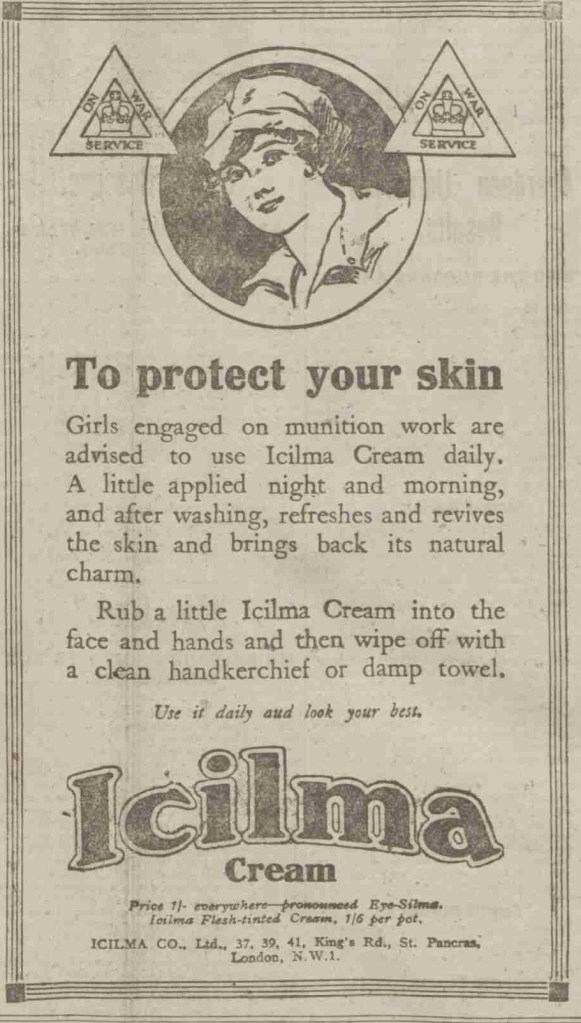
The middle and upper classes saw excessive make-up as a marker of the lower classes. But the working-class women who worked in the munition factories may well have felt the need to use extra makeup in order to hide the resulting skin discolouration caused by contact with T.N.T. The upper-class Mrs Alec-Tweedie wrote disparagingly of the ‘tawdry finery’ of ‘the usual working-class girl’ remarking that ‘the factory hand has been known to pull out her mirror, puff-box and rouge in the middle of a twelve hours’ night shift…’[15] An article in the Daily Mirror actually featured the news:
A “run” was also made by munition girls on face creams, powders and manicure sets for faces and hands “honourably worn” in munition factories. Many of the “Canary girls,” The Daily Mirror learned, were asking for creams to remove some of their “tan”.
“Wise girls prepare for holidays.” The Daily Mirror, 18th May 1918. p.2
The use of the word tan both identifies the women as working class, due to a skin colour associated with working outside, but it also diminishes the harmful side effects of munitions work. As does the postcard by Fred Spurgin ‘Don’t go putting the powder where it is not wanted!’ (Figure 5) which plays on the suggested dual uses of powder. Depicting the female munition worker’s concern with her appearance, as well as hinting in a playful manner of the dangers of a slapdash approach to working with the explosive chemicals. The female munition worker is portrayed in Spurgin’s artistic style with a cinched-in waist, curls protruding from under her cap, wearing stockings and high heels, and heavily made-up.

This theme also features on the postcard ‘The Munition Girl’s Toilet’ (Figure 6), which shows a childlike munition worker standing on a newspaper powdering her face using the shiny surface of the shell as a mirror.
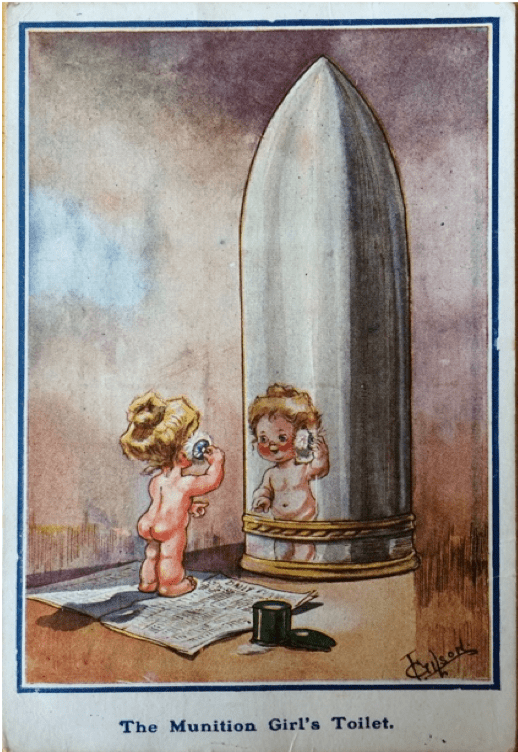
The Yarmouth Independent reported in 1916 a meeting that occurred, part of a recruitment drive to encourage women to work in munitions. Warning that working with certain powders may change women’s complexion for a few days a Miss Winifred Gardiner, who ‘pleasantly described work in munition factory’ claimed that the women would not even mind their faces turning yellow when they thought about what their men were suffering at the Front.[16]
Instances were reported when a happy or positive outcome could be disseminated for morale, such as Agnes Mary Peters, a munition worker at the Woolwich Arsenal, who was blinded only a week after entering the Daily Mirror’s Beauty Contest but still received £10 prize money from the newspaper. (Figure 7) She was awarded the Order of the British Empire: “[F]or great courage and high example in continuing to do work of an exceptionally dangerous nature which finally resulted in an accident, by which she was totally blinded and otherwise injured.”[17] Later, in 1920, she married a soldier she had met at St Dunstan’s Home for the Blind in Saltdean, near Brighton (Figure 8).
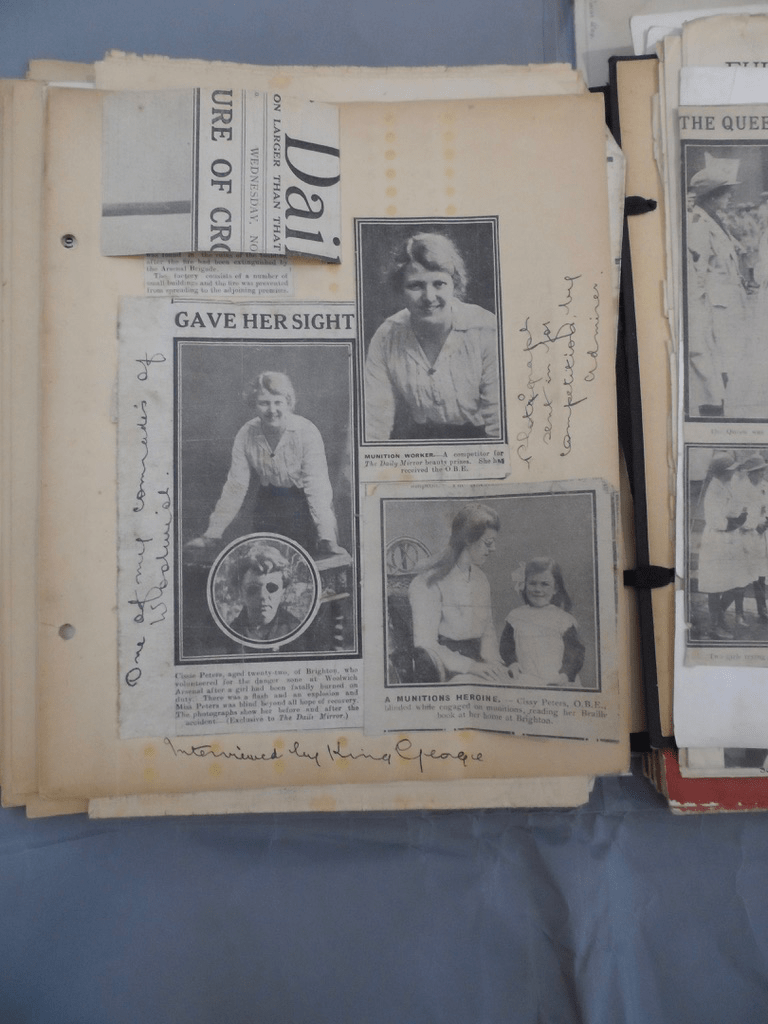
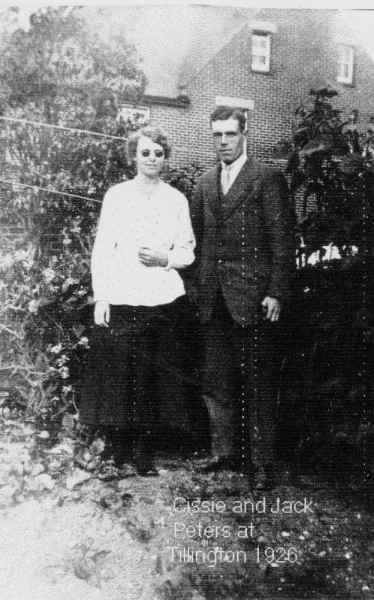
Other women who were awarded O.B.E.s included Netta (Elspeth) Daniel, Isabella Dixon, Maude Bruce (Figure 9), Jenny Algar, Gladys Herrington and L.M. Ede, an examiner. Another young girl, Mabel Lethbridge, from an upper-class family wrote about her experiences in a book Fortune Grass published after the war in 1934. She described the explosion at the Hayes filling factory in which she lost a leg, but her story was reported at the time using positive hyperbolic language. The announcement of her O.B.E praised her ‘courage and high example shown on the occasion of an accident in a filling factory, causing loss of one leg and severe injuries to the other.'[18]
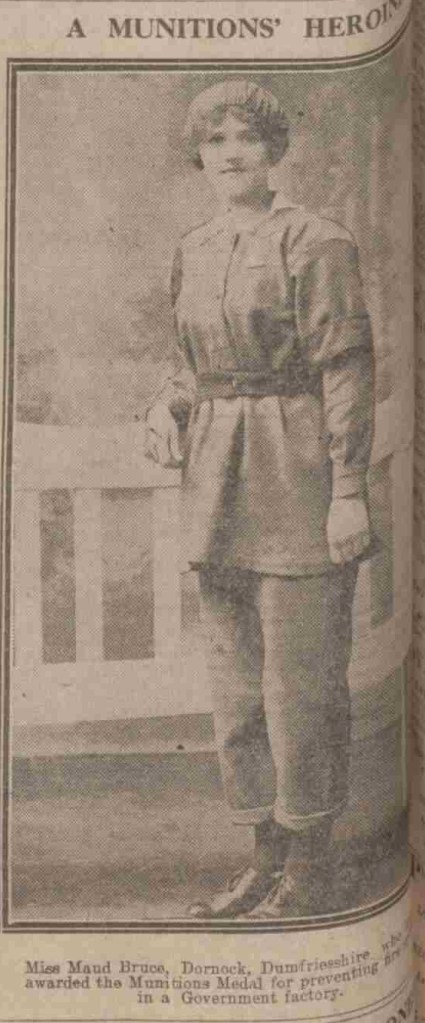
Feminine characteristics of selfless care for others before oneself is demonstrated in the case of Margaret Winifred Burdett-Coutts who, after losing a finger and badly lacerating her hand in a circular saw “went quietly. away to have it treated in order not to unnerve her fellow workers.” She apparently felt that:
“the price I’ve paid for doing my duty is a light one compared with the wounds and sufferings of the brave lads out in the trenches. I think it is up to us women ‘to do our bit’ as far as we can”
Herfordshire Express, 14th January 1918, N.P.
Included in the archive of the IWM are photographs that form a memorialisation of female munition workers and details of the cause of death. The relations of one worker Mrs Margaret Armer Bradshaw donated two photographs, one of her in her munition workwear (Figure 10) and the other of her with her children and husband (Figure 11). She was killed by an explosion at the Liverpool filling factory at Aintree on 23rd July 1918.


The fact that they included both photographs gave her memory some humanity and pathos as she was remembered for her contribution to the war effort but also as a mother and wife. The Scotsman reported in June 1917 that accidents with explosives had increased from 485 in 1915 to 641 in 1917 but how accurate this figure was is questionable. It seems that only when the explosions were too conspicuous, because of the scale and devastation of the damage or loss of life, that they were reported. Injuries that were sustained were viewed in comparison with those suffered by serving men at the Front. Women were always viewed as serving or conforming to expected notions of duty but, their injuries and, or the visible manifestation of their work would have been apparent to the public in very visible ways during the war. However, the decommissioning of weaponry after the war was also fraught with danger. Reports of the inquest of those who perished in the 1924 explosion at the Slade Green factory, Erith, Kent, where cartridges were being dismantled, listed 12 women who died.[19] As late as 1924 when the Erith accident occurred, munition work was still hazardous but the longer reaching effects of working with the toxic chemicals had and would continue to take their toll on women’s bodies leaving them unable to conceive and suffering from the side effects of the toxic chemicals for the rest of their lives.
Endnotes:
1 Cosens, Monica, Lloyd George’s Munitions Girls. London, Hutchinson & Co.1916. Print. p.69
2 Daggert, Mabel, Women Wanted: The Story Written in Blood Red Letters on the Horizon of the Great World War. New York: George H. Doran Co., 1918
3 Mrs. Alec-Tweedie, Women and Soldiers. New York: John Lane Company, 1918. Print.
4 The “Manchester Guardian” p.299. N.D.
5 Notes on the Employment of Women on Munitions of War. London: His Majesty’s Stationery Office. 1916
6 Laws, Bill (editor), In The Munitions: Women at War in Herefordshire. Herefordshire: Logaston Press, 2003. Print. p.11.
7 “Dangers of Munition Workers” The Workers’ Dreadnought, 29th September 1917, Vol. IV. – No. 27 p.1
8 http://www.20thcenturylondon.org.uk/server.php?show=conInformationRecord.207. Accessed January 2015. Hartlepool Northern Daily, 23 January 1917 p.2
9 http://www.barwickinelmethistoricalsociety.co./4746.html. Accessed 25.5.14. Sheffield Daily Telegraph 7th December 1916 p.6
10 Woollacott, Angela, On Her Their Lives Depend, Munitions Workers in the Great War. California: University of California Press, 1994, p. 81
11 Barker, Lilian, Welfare Report, Woolwich Arsenal, May 1919, Ministry of Munitions, National Archives, London, Document Reference: MUN/5/92/346/33.
12 Parry, Miss D, Welfare Report, Ministry of Munitions, National Archives, London, Document Reference: MUN/5/92
13 Richardson, Jennifer, Female Munition Workers Dress in Britain 1914-1918: A Visual and Material Culture Analysis. PhD University of Brighton, 2019. p.136
14 Circular no 36, 26th November 1915, Ministry of Munitions Archives, National Archives, London, Document Reference: MUN/5/147.
15 Mrs Alec-Tweedie (1918) p.55
16 Yarmouth Independent – Saturday 18 November 1916 p.6
17 Sheffield Daily Telegraph, 9th January 1918 p.6
18 Sheffield Independent – Friday 02 November 1934 p.6
19 Sheffield Daily Telegraph 21st February 1924 p.5
References:
Mrs. Alec-Tweedie, Women and Soldiers. New York: John Lane Company, 1918. Print.
Cosens, Monica, Lloyd George’s Munitions Girls. London, Hutchinson & Co. 1916. Print.
Daggert, Mabel, Women Wanted:The Story Written in Blood Red Letters on the Horizon of the Great World War. New York: George H. Doran Co., 1918. Print.
Laws, Bill (editor), In The Munitions: Women at War in Herefordshire. Herefordshire: Logaston Press, 2003. Print.
Richardson, Jennifer, Female Munition Workers Dress in Britain 1914-1918: A Visual and Material Culture Analysis. PhD University of Brighton, 2019. Print.
Woollacott, Angela, On Her Their Lives Depend, Munitions Workers in the Great War. California: University of California Press, 1994. Print.


